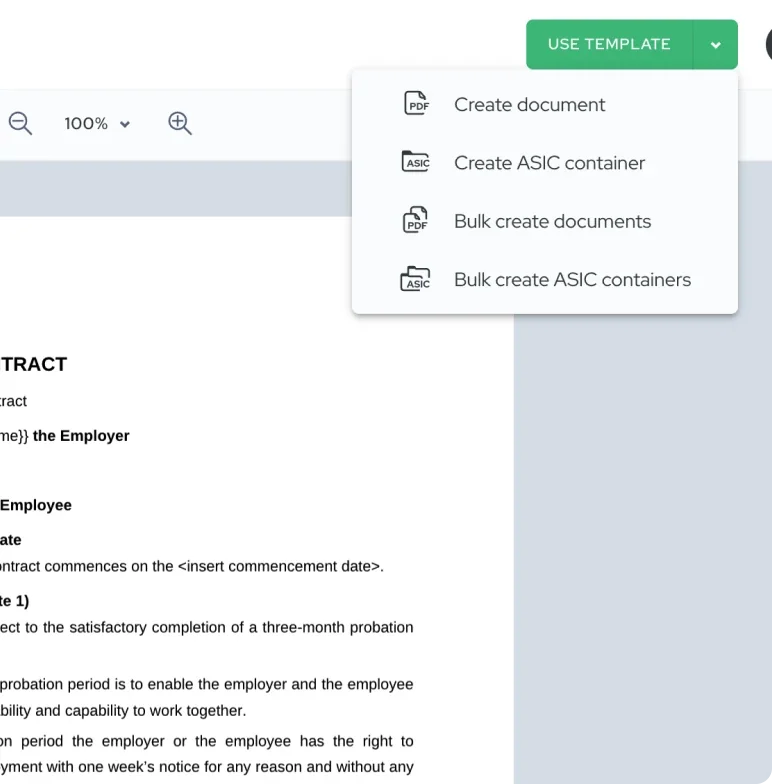Multi-File Documents: Working with ASIC Containers

Create and manage multi-file document packages using ASIC containers. Learn how to bundle contracts with attachments, technical specifications, and supporting documents into a single signed package.
ASIC containers let you bundle multiple files together and sign them all with a single signature set. One contract, three appendices, two technical drawings—all in one package, all signed at once.
What Multi-File Documents Solve
Traditional signing handles one file at a time. If your contract includes attachments, you either combine everything into one PDF (losing original formats) or manage separate signing workflows for each file.
ASIC containers work differently. You package multiple files together—any file type—and signers review and sign the complete set with one action.
This matters for complex agreements. A construction contract includes the main agreement, architectural drawings (CAD files), material specifications (Excel), and project timeline (PDF). With ASIC, all files sign together. No file gets missed. No version confusion.

Creating Multi-File Documents
Start with format selection. During document preparation, choose ASIC or EDOC as your output format. PDF does not support multiple files.
Upload your files. Add all documents to the container:
- Main contract (PDF, Word, or any format)
- Appendices and exhibits
- Supporting documents (spreadsheets, images, technical files)
- ZIP archives (if you need to package related items)
No file type restrictions. ASIC accepts PDFs, Word documents, Excel spreadsheets, images, CAD drawings, ZIP files—anything your agreement needs.

Set up signing. Add signers, configure signature order, and send invitations. Signers see all files in one interface.
Multi-file containers help organizations prevent missing attachment errors and ensure all related documents remain together throughout the signing process.
How ASIC Containers Work
Container structure: ASIC uses a ZIP-like archive format. Your files stay in their original formats. Signatures store separately in a META-INF folder.
document.asice (ZIP archive)
├── contract.pdf
├── specifications.docx
├── budget.xlsx
├── drawings.zip
└── META-INF/
├── manifest.xml
└── signatures.xml
All-or-nothing signing: One signature covers the entire container. You cannot selectively sign individual files within the package. This ensures all parties sign the complete agreement.
File integrity: The signature validation checks the entire container. If anyone modifies any file after signing, the signature becomes invalid.
Signer Experience
Signers receive one email invitation. They open the signing interface and see a list of all files in the container.
Reviewing files: Signers can open and review each file individually. The interface shows file names, types, and sizes. Signers check each document before signing.
Single signing action: After reviewing all files, signers sign once. That signature applies to the entire package—all files together.
Receiving signed documents: Once complete, all signers receive the fully signed ASIC container with all files and signatures included.
Common Use Cases
Contracts with attachments: Employment agreements include the main contract, NDA, employee handbook, and benefits enrollment forms. Sign everything together—employee reviews all documents in one session.
Project documentation: Construction projects bundle proposals, technical specifications, architectural drawings, material lists, and project schedules. All stakeholders sign the complete package.
Compliance packages: HR policies include the main policy document, acknowledgment forms, training materials, and compliance certifications. Employees sign once, confirming receipt of everything.
Real estate transactions: Purchase agreements come with property disclosures, inspection reports, title documents, and mortgage terms. Buyers and sellers sign the complete transaction package.
Vendor agreements: Service contracts attach statements of work, pricing schedules, SLA documents, and data processing agreements. Both parties sign one comprehensive package.
Technical Requirements
QES only: ASIC containers require Qualified Electronic Signatures. Simple or Advanced signatures are not available. This automatic enforcement ensures highest security.
Compatible viewers: Signed ASIC containers require ASIC-compatible software (like DigiDoc) to open. Standard PDF readers cannot view ASIC files.
Fillable fields: You can use {{curly_brackets}} fields across all files in the container. Signers fill in data that populates throughout the document package.
File size limits: No specific limit on number of files. Practical limits depend on total container size and platform constraints.
Signature validation: ASIC viewers validate signatures and show all files with signature status. The validation confirms that no files have been modified since signing.
Benefits of Multi-File Signing
No missing attachments: All files package together. Nothing gets forgotten. Signers cannot sign the main contract without seeing the appendices.
Original file formats: Files stay in their native formats. CAD files remain CAD. Spreadsheets remain spreadsheets. No conversion to PDF required.
Single workflow: One signing process for multiple files. Reduces coordination effort and speeds up complex agreements.
Stronger compliance: Courts and regulators see complete agreement packages with unified signatures.
When Not to Use Multi-File Containers
Simple agreements: Single-file contracts work better with PDF format. More universal compatibility.
Need visual signatures: ASIC does not support signature boxes inside documents. Use PDF if visual signatures are required.
Recipients lack compatible viewers: If signers cannot install ASIC viewer software, PDF provides better accessibility.
Non-EU signers without QES: ASIC requires QES methods (Smart-ID, Mobile-ID, eID cards). If signers do not have access to these methods, use PDF format instead.

